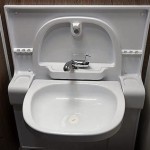How To Clean Bathroom Grout Without Bleach
Bathroom grout, the porous material filling the spaces between tiles, is particularly susceptible to discoloration and the accumulation of mold, mildew, and soap scum. Regularly cleaning grout is essential not only for aesthetic reasons but also for maintaining a healthy bathroom environment. While bleach is a common grout cleaning agent, its harsh chemicals can be detrimental to both human health and the environment. This article outlines effective, bleach-free methods for cleaning bathroom grout, providing alternatives that are both safer and environmentally conscious.
Understanding Grout and Its Vulnerabilities
Grout, typically composed of a mixture of cement, sand, and water, is inherently porous. This porosity allows water and various substances to penetrate the surface, creating a breeding ground for mold and mildew. The bathroom environment, characterized by high humidity and frequent water exposure, exacerbates this issue. Soap scum, a byproduct of soap reacting with hard water minerals, also contributes to grout discoloration. Over time, the accumulation of these substances can lead to staining and degradation of the grout, impacting the overall appearance and hygiene of the bathroom.
The use of bleach, while effective in killing mold and whitening grout, presents several drawbacks. Bleach releases harmful fumes that can irritate the respiratory system and eyes. Prolonged exposure can also damage the grout itself, weakening its structure and increasing its porosity. Furthermore, bleach is a potent environmental pollutant, contributing to water contamination and harming aquatic life. Therefore, exploring bleach-free alternatives is a prudent approach to bathroom grout cleaning.
Key Ingredients for Bleach-Free Grout Cleaning
Several common household ingredients possess effective cleaning properties and can be used as alternatives to bleach for grout cleaning. These include:
*Baking Soda: A mild abrasive and deodorizer, baking soda is effective in removing dirt, grime, and stains from grout. Its alkaline nature also helps to neutralize acidic substances, such as soap scum.
*Vinegar: Acetic acid, the active ingredient in vinegar, is a natural disinfectant and cleaner. It effectively dissolves hard water stains, soap scum, and mildew. White vinegar is generally preferred for cleaning purposes due to its lack of color, which minimizes the risk of staining light-colored grout.
*Hydrogen Peroxide: A mild bleaching agent and disinfectant, hydrogen peroxide is effective in removing stains and killing mold and mildew. It is generally considered safer than bleach, as it decomposes into water and oxygen.
*Dish Soap: A degreasing agent, dish soap helps to loosen and remove dirt and grime from grout. It is particularly effective in addressing soap scum buildup.
*Borax: A natural mineral with cleaning and disinfecting properties, borax can be used to remove stains and kill mold and mildew. It is also an effective deodorizer.
Methods for Bleach-Free Grout Cleaning
Several methods can be employed to clean bathroom grout without the use of bleach, utilizing the aforementioned ingredients. The choice of method depends on the severity of the grout staining and the desired level of cleaning power.
1. Baking Soda Paste
A baking soda paste is a gentle yet effective method for cleaning grout. To prepare the paste, mix baking soda with water until a thick, spreadable consistency is achieved. Apply the paste liberally to the grout lines, ensuring complete coverage. Allow the paste to sit for several minutes, preferably 10-15 minutes, to allow the baking soda to penetrate and loosen the dirt and grime. Use a stiff-bristled brush, such as an old toothbrush or grout brush, to scrub the grout lines vigorously. Rinse the grout thoroughly with clean water to remove any remaining baking soda residue. Repeat the process as needed for stubborn stains.
2. Vinegar and Baking Soda Combination
The combination of vinegar and baking soda creates a powerful cleaning action. This method is particularly effective for removing stubborn stains and mildew. Begin by sprinkling baking soda liberally over the grout lines. Then, pour white vinegar onto the baking soda. The mixture will fizz, creating a chemical reaction that helps to loosen dirt and grime. Allow the mixture to sit for several minutes, preferably 5-10 minutes. Use a stiff-bristled brush to scrub the grout lines vigorously. Rinse the grout thoroughly with clean water. Ensure adequate ventilation when using vinegar.
3. Hydrogen Peroxide Application
Hydrogen peroxide is a mild bleaching agent that can effectively remove stains and kill mold and mildew. Apply hydrogen peroxide directly to the grout lines, ensuring complete coverage. Allow the hydrogen peroxide to sit for several minutes, preferably 10-15 minutes. Use a stiff-bristled brush to scrub the grout lines vigorously. Rinse the grout thoroughly with clean water. For more stubborn stains, consider using a higher concentration of hydrogen peroxide (3% is commonly available for household use). Test on an inconspicuous area first to ensure it does not discolor the grout.
4. Dish Soap Solution
A dish soap solution is effective for removing soap scum and general grime from grout. Mix a few drops of dish soap with warm water to create a soapy solution. Apply the solution to the grout lines using a sponge or cloth. Allow the solution to sit for a few minutes to loosen the dirt and grime. Use a stiff-bristled brush to scrub the grout lines vigorously. Rinse the grout thoroughly with clean water. This method is particularly suitable for regular maintenance cleaning.
5. Borax Paste
Borax provides a strong cleaning action that can tackle tougher stains and mold. To prepare the borax paste, mix borax with water until a thick consistency is reached. Apply the paste to the grout lines and let it sit for about ten minutes. Use the scrub brush to clean the grout, and then rinse well with clean water. Ensure to follow safety precautions when handling borax, such as wearing gloves.
Tools for Effective Grout Cleaning
The right tools enhance the efficiency and effectiveness of grout cleaning. These include:
*Stiff-Bristled Brush: A stiff-bristled brush, such as an old toothbrush or grout brush, is essential for scrubbing the grout lines. The bristles should be firm enough to dislodge dirt and grime but not so abrasive as to damage the grout.
*Spray Bottle: A spray bottle is useful for applying cleaning solutions to the grout lines in a controlled manner. This helps to ensure even coverage and minimizes waste.
*Sponge or Cloth: A sponge or cloth is useful for applying cleaning solutions, wiping away excess residue, and rinsing the grout.
*Rubber Gloves: Rubber gloves protect hands from prolonged contact with cleaning solutions and prevent skin irritation.
*Safety Glasses: When working with cleaning solutions, safety glasses will help protect the eyes from accidental splashes.
Preventative Measures for Maintaining Clean Grout
Preventing grout from becoming excessively dirty is more efficient than attempting to clean heavily stained grout. Several preventative measures can be implemented to minimize grout discoloration and maintain a clean bathroom environment.
*Regular Cleaning: Cleaning grout regularly, at least once a week, prevents the accumulation of dirt, grime, and mold. A simple solution of dish soap and water can be used for routine maintenance cleaning.
*Proper Ventilation: Ensuring adequate ventilation in the bathroom helps to reduce humidity levels, which in turn inhibits mold and mildew growth. Opening a window or using an exhaust fan after showering or bathing promotes air circulation and reduces moisture buildup.
*Sealing Grout: Applying a grout sealant helps to protect the grout from water penetration and staining. Grout sealants create a barrier that prevents liquids and substances from being absorbed into the grout's pores. Reapply the sealant periodically, as recommended by the manufacturer.
*Wiping Down Surfaces: After showering or bathing, wipe down tiled surfaces with a towel or squeegee to remove excess water and prevent water spots and soap scum buildup.
*Using Shower Sprays: Daily shower sprays can help prevent the buildup of soap scum. Look for natural or environmentally friendly options.
Alternative Cleaning Solutions
Besides commonly used household items, some commercial cleaning solutions can be used in place of bleach to effectively clean tile grout:
*Enzyme Cleaners: Enzyme cleaners are effective when dealing with organic stains like mold, mildew, and bodily fluids. The enzymes break down these organic compounds, making them easier to remove. Follow the product instructions diligently to gain optimal results.
*Oxygen Bleach Cleaners: Oxygen bleach cleaners, unlike chlorine bleach, are non-toxic and odorless, and are more biodegradable. They are effective in brightening the grout and removing stains without the harshness and safety concerns associated with traditional bleach.
*Steam Cleaners: Steam cleaners utilize high-temperature steam to disinfect and clean grout, loosening dirt and grime without the need for any chemical agents. The steam effectively kills mold and other bacteria, making it a safe, non-toxic, and environmentally sound option for grout maintenance.
By implementing these bleach-free cleaning methods and preventative measures, individuals can maintain clean and healthy bathroom grout without compromising their health or the environment. Regular maintenance and the use of appropriate cleaning agents will ensure the longevity and aesthetic appeal of tiled surfaces.

How To Clean Grout Dirty In Five Minutes Without Using Bleach Express Co

How To Clean Grout With A Homemade Cleaner Practically Functional

How To Clean Mold In Shower Grout Tips And Tricks Certified Care

How To Clean Grout Without Bleach Easy Method Lifts All Dirt And Grime From Tile Express Co

The Ultimate Guide To Cleaning Grout 10 Diy Tile Cleaners Tested Bren Did

The Ultimate Guide To Cleaning Grout 10 Diy Tile Cleaners Tested Bren Did

How To Clean Grout Without Bleach Easy Method Lifts All Dirt And Grime From Tile Express Co

I Cleaned My Bathroom Grout And Removed Stains In Two Minutes Without Bleach Here S How Express Co

The Easiest Way To Clean Grout Without Scrubbing Maid2match

Black Mold In The Shower How To Clean It Kitchen With Matt







